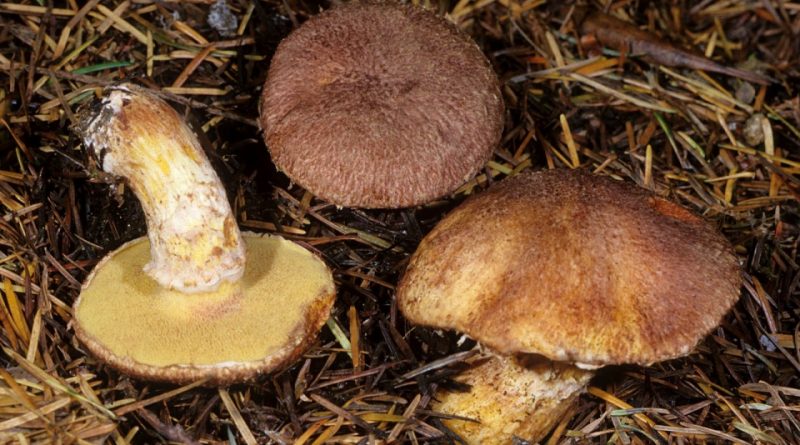Suillus lakei
Suillus lakei
Suillus lakei (Suillus lakei (Murrill) Smith & Thiers, 1964) is a basidiomycete fungus belonging to the Suillaceae family.
Systematics –
From the systematic point of view it belongs to the Eukaryota Domain, Fungi Kingdom, Basidiomycota Division, Basidiomycetes Class, Boletales Order, Suillaceae Family and therefore to the Suillus Genus and to the S. lakei Species. The terms are Boletus lakei (Murrill) Singer 1942 and Boletinus lakei (Murrill) Singer 1945 are synonyms.
Etymology –
The term Suillus is the diminutive of sus, súis, pig: piglet, due to the particularly abundant size of this genus of mushrooms. The specific epithet lakei was given in honor of the mycologist E.R. Lake of the Oregon Agricultural College (now Oregon State University).
Geographical Distribution and Habitat –
Suillus lakei is a symbiont mushroom, of North American origin, where it is quite widespread, while in Europe it is quite rare. In Italy it is present in Calabria in the reforestations of Spruce of Douglas (Pseudotsuga menziesii). The fungus is in fact linked to the Douglas Fir (Pseudotsuga menziesii) with which it forms mycorrhizae. The fruiting period is that of the beginning of autumn, single or in several specimens grouped at the base between them.
Recognition –
This fungus is recognized for having a cap of 4-15 cm in diameter, initially hemispherical, convex, then flat with sometimes a depression at the center, fleshy, with a convoluted margin then distended, often covered with remains of partial veil.
The cuticle is dry, removable, covered with thick dark scales, reddish brown or orange on a yellowish background.
The hymenophore is characterized by decurrent, long, yellow tubules with angular pores, radially arranged polygonal, yellow or yellowish and turning blue if touched.
The stem is 3-7 cm long, short, stocky, full, more or less enlarged at the base, yellow, whitish in the upper part and covered with small fibrils that look like a veil, while in the lower part is brown reddish. There is a fluffy ring that soon vanishes leaving a thin whitish thread.
The flesh is firm and thick, yellow in color that becomes reddish with age; if cut it turns green and blue and has a fruity and sweet-smelling flavor.
At the microscope, elliptic-fusiform spores of 7.5 -11 x 3-4 µ are noted, smooth and clavate, tetrasporic, rarely bisporic, of 25-35 x 9-12 µm.
Cultivation –
Suillus lakei is not a cultivated mushroom.
Uses and Traditions –
This mushroom, native to North America, was also found in the internal Apennine area (Municipality of Apecchio in October 2006, in a reforestation of Pseudotsuga menziesii and Pinus nigra) and never found again. It is present in Calabria on the Sila always on reforestation of Pseudotsuga menziesii.
It can be exchanged for similar species such as:
– Suillus lakei var. Lavorate calabrus, which has a lighter, yellowish cap with detersile scales, at the end of a vinous red color;
– Suillus lakei var. pseudopictus Smith & Thiers, which stands out for the colors of the darker red pileus, the thicker scales that leave no glimpse of the yellowish background.
Other fairly similar Suillus associated with Douglas Fir are:
– Suillus caerulescens Smith & Thiers, which is separated by the canella-colored cap, discolored to yellow towards the margin, usually slimy, spores up to 5 µm;
– Suillus ponderosus Smith & Thiers, which has a large smooth hat of up to 25 cm, slimy, the lower face of the ring is glutinous orange;
– Suillus imitatus Smith & Thiers, which has a brown to reddish brown cap, smooth and decidedly glutinous, yellowish flesh, unchanging at the section.
Suillus lakei is a fungus of poor edibility and is not recommended as it is slightly laxative.
Preparation Mode –
Suillus lakei, although edible, is not recommended for its laxative properties. Obviously the presence of some carpophore in a mixture of mushrooms can obviously be tolerated.
Guido Bissanti
Sources
– Wikipedia, the free encyclopedia.– Cetto B., 2008. The mushrooms from life, Saturnia, Trento.– Pignatti S., 1982. Flora of Italy, Edagricole, Bologna.– Conti F., Abbate G., Alessandrini A., Blasi C. (ed.), 2005. An annotated checklist of the Italian vascular flora, Palombi Editore.
Attention: Pharmaceutical applications and food uses are indicated for informational purposes only, do not represent in any way a prescription doctor; therefore no responsibility is assumed for their use for curative, aesthetic or food purposes.

